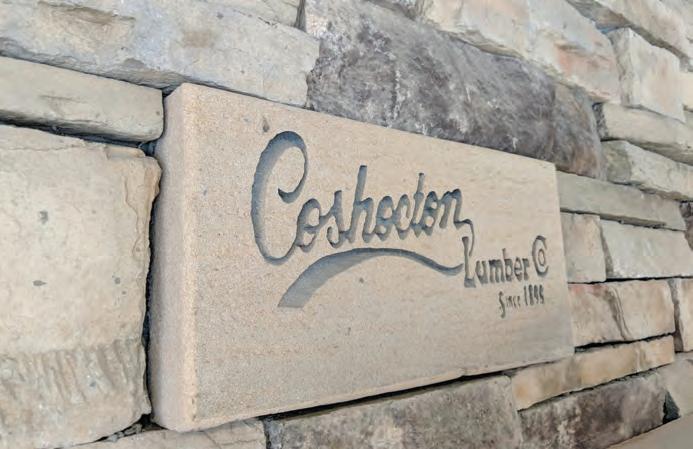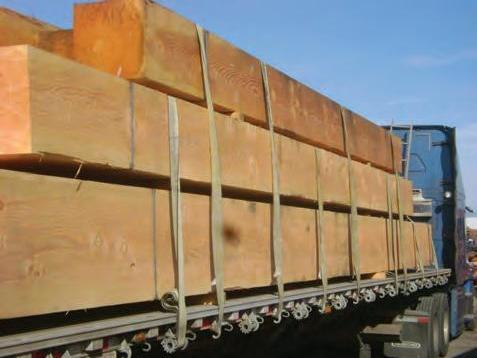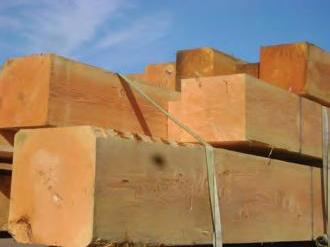
9 minute read
coMPetItIve IntellIgence
Older but stronger
VENERABLE OHIO dealer Coshocton Lumber draws on tons of experience and relationships.
“It’s sad, the way things are going in Ohio,” says Joel Jumper, owner of Coshocton Lumber, named for the town of 12,000 that’s nowhere near Cleveland and its potent medical industry nor Columbus with its thriving fashion base. In fact, it’s not even nudging an interstate that leads to either pulsing city.
It’s—frankly—“rural,” says Joel. “You’ve got to really want to come here; it won’t be by accident. And we’ve lost a tremendous amount of industry in town.”
Nonetheless, Joel is so swamped with business that he can barely snatch time to come to the phone.
He took over the business from his father 20 years ago, tackling an outfit that had been launched in 1898 and purchased by Joel’s grandfather, a builder, in 1944—just in time to welcome his son back from military service after World War II.
Joel himself returned in 1978 at age 21. “I was going to stay on in Indiana with a friend, but I was also dating a girl from Coshocton.” So when his dad called, saying “Come back: I need help,” Indiana was put on hold and his relationships—business and romantic—moved forward.
“I worked a bit alongside Dad, but he’d soon had enough, and it was time for me to take over. I was like a deer in the headlights. I began by tweaking a few things, like changing the trucks around and adding new products.”
But what he did not do was revamp that which any other industry pro might, at his most diplomatic, call a “quirky” layout. “If you came in the store, you’d be shocked,” Joel guarantees. “You’d expect to park at the front and walk in the front door, but no: It’s the reversal of everything they tell you to do. You walk into the sales counter, right up front. Plus,” he adds, “the ceiling is 7 feet, 6 inches high!”
Joel’s business today is fueled by a healthy mix: 40% contractors, 40% walk-ins, and 20% industrial. And it’s growing. “Ironically,” he laughs, “people are coming back here to retire, buying acreage, building houses. I’ve pushed our deliveries farther out.
“Our biggest competitors are the
C&E LUMBER COMPANY
1 1/2” to 12” Diameter in Stock.

Amish [independent yards], along with all the boxes: Depot, Lowe’s. Where we can beat them, “he declares, “is with our service—especially delivery: Call in the morning, and we’ll have it out the same day. We run our trucks hard all the time. It’s never ‘We’ll get it to you by Tuesday,’ but rather, ‘When do you want it?’ We make it work.”
Joel can count on a staff of 20 to make the impossible happen. “Everybody works on everything— not in a special department. I tell them, ‘The more you know, the better you do.’ Normally, we’d give them training, of course, but nowadays it’s so busy that it’s sink or swim. But that way, they learn from their mistakes. There’s a lot of leeway; I don’t micro-manage. I’m not standing over them. They’ve got free rein to make decisions.” And he’s mighty glad they’re there. “Everybody’s looking for people right now. I just lost one person but picked up two more. In a diner, if the girl who waits on you is good… you make an offer; they’ll learn the stuff.”
And learn they do. That’s what Coshocton’s pros appreciate most, in Joel’s opinion. “There’s a lot of knowledge on board here—and always a way around a problem. If there’s no vinyl siding at Point A, try Point B— and get it to our customer in a timely manner. Nobody else in the industry wants to do that, especially the boxes. Here, a contractor can focus on one guy [employee] who’ll handle the whole situation, taking it one piece at a time.
“We also build things from scratch in our shop for a couple of places— custom cutting. We have a lumber mill, which is actually more of a woodworking shop. We also have a strong Kitchen & Bath department, run by a young lady who does a really good job, mostly dealing with walkins. We also sell a lot of hardware, a lot of paint. And I still stock paneling: I’m surprised at how much of it we sell—and at good margins.”
Sure, Joel agrees with all of you out there, product is hard to get—“hard last year, and this year even harder. First it was hardware, then lumber; now, it’s both. We really have to dance around, trying to find product. I used to make one call; now, it’s four or five to get what you need.”
Light at the end of the tunnel? “My guess,” he says, “is…no. Not until the end of next year. I talk to the steel plant (I need steel for pole barns) and
•Gazebos – providing more shelter clearly, it won’t end soon. And that than a pergola, gazebos offer a point trickles down to screws, power tools, of retreat and greater protection batteries. Batteries” he underscores, from the elements without isolating “are real scarce. I usually have 50, inhabitants. 100 batteries around. Now… none. •Exposed Timber structures – the natural color and grain of redwood timbers lend a solid support to a greater structural design. It’s a big shortage. And my co-op just notified us that there’s a shortage of dust pans. Dust pans? Really???” Rubbing salt into the wounds of economic turmoil, this reporter •Decks – a redwood deck can last a lifetime when it’s built and maintained well. asks about the company’s website development. “It’s moving slowly, real slowly, and we need to do a lot more with that, but we’re so busy. So •Planters – non-toxic and all nat- for now, we just fall back on what we ural, redwood is ideal for garden have”—which does include consumerboxes and planters to hold flowering friendly how-tos and buying guides. plants, herbs, even vegetable gardens. What does the future hold for the •Furniture – any form of seating, tables, benches all deliver the promise of a comfortable place to gather when built with redwood. •Arbors – create memorable transitions from one part of a yard to the company? Joel’s three kids are happily employed in different professions elsewhere, “and I’m 64,” he notes. “It kind of snuck up on me” while the world was changing. “There used to be five lumberyards in the county; now, we’re down to one.” INCREASINGLY backyard builders are realizing that the best contemporary design materials aren’t grown in the lab, but out in unfiltered nature. next with redwood arbors. Still, Joel’s in no hurry for the Among the trends emerging in landscaping design, there’s no better fit for bringing beauty, color and presrocking chair and the gold watch. “I love the diversity of everything here; each day it’s always different.” ence into an outdoor space than redwood. Combined with its longevity, and environmental qualities, redwood – Can the industry benefit from hearing your yard’s story? Contact Carla Waldemar at cwaldemar@comcast.net.
is the top choice among landscaping trends. It is a choice any consumer can make with confidence, and reaffirm their wise decision year after year.
said. “Every now and then a little rumor pops up that auto scanners are taking the place of good people, and that’s just not the case.”
Coulombe agrees: “When we started this journey, we knew it would be a big change for our folks; our graders are some of our best employees, valued and important pieces of our organization, and we didn’t want to lose any of them. In our case, we took former line graders and put them in roles like scanner technician to keep their expertise close at hand.”
Challenges Along the Way
As is often the case with technology, there were challenges as the new tools were implemented at Irving Forest Products. Initial technology had issues with identifying decay due to its color, among other things. The installation process required lots of checking by people—lots of man hours—to get it started and up and running accurately. Constant checks were the name of the game for a while, but Coulombe says those issues are in the past.
“The key to success with new technology is to assign someone to take ownership of the program or equipment and really usher it through the quality control checks, the calls with the manufacturer, etc.,” Coulombe commented. “Precise technology at this level will never be set-it-andforget-it; just when you think you’ve hit that sweet spot, a fleck of dirt on the lens shows up as a defect. It’s a constant –Jessica Hewitt is director of marketprocess, but worth the effort.” ing at Humboldt Redwood Company. HRC is working to cultivate a lasting legacy of To Each His Own By Easterling’s estimates, maybe 10% of NELMA mills use auto grading equipment. With the technology still fairenvironmentally responsible forestry and sourcing, manufacturing, and distribution of top-quality redwood lumber products. ly new to the lumber industry in the Northeast and Great Lakes, this number is expected to grow a bit over the next few years. “The technology isn’t for everyone,” he concluded. “For smaller mills, the ROI won’t ever be there—and they will continue to be successful. For our larger ones, this may be something more of them may consider in the years to come.” “The technology will continue to improve, and we expect to see more industry peers getting on board,” said Coulombe. “Is it worth it for Irving Forest Products? Without a doubt. The benefits far outweigh the challenges, and the equipment we’ve chosen is helping us to better serve our customers’ ever-changing needs, and that’s what it’s really all about.”
SFI Growing Certification of Family Lands
The Sustainable Forestry Initiative and the American Forest Foundation have formed a new partnership to grow the amount of certified family and other small holdings in North America. Under their new Small Lands Group Certification Module, companies certified to the SFI Fiber Sourcing Standard will be able to form a new type of certification group to certify small lands within their wood and fiber supply area. The Module will be submitted to the Programme for the Endorsement of Forest Certification (PEFC) for approval this spring. Upon approval, fiber produced from lands certified under the program will be certified for both PEFC and SFI labels and chain-of-custody systems.
Santa Fe Springs, Ca • www.hufflumber.net (800) 347-4833

EWP • Big Timbers/Long Lengths • Distressed Wood • D-Blaze® FRTW
Wholesale distributor of a wide range of Big Timbers & Long Lengths, including DOUGLAS FIR – #2&BTR & SEL STR Green/Dry DF
S4S Dimensional Lumber 2×4 – 2×14 up to 32’ #2&BTR DF S4S 3×4 – 3×12 to 24’ & 4×4 – 4×14 #1&BTR DF S4S 6×6 – 6×14

Larger pieces available depending on current inventory

Rough Timbers

3×4 – 3×12 (8’ to 40’) 4×4 – 4×12 (8 to 40’) 6×6 – 6×12 (8’ to 40’) 8×8 – 8×12 (8’ to 40’) 10×10 – 10×12 (8’ to 40’) 12×12 ( 8’ to 40’) Up to 16’ x 24’ – 48’
the finest timbers available, delivered to customers accurately, honestly & on time.











